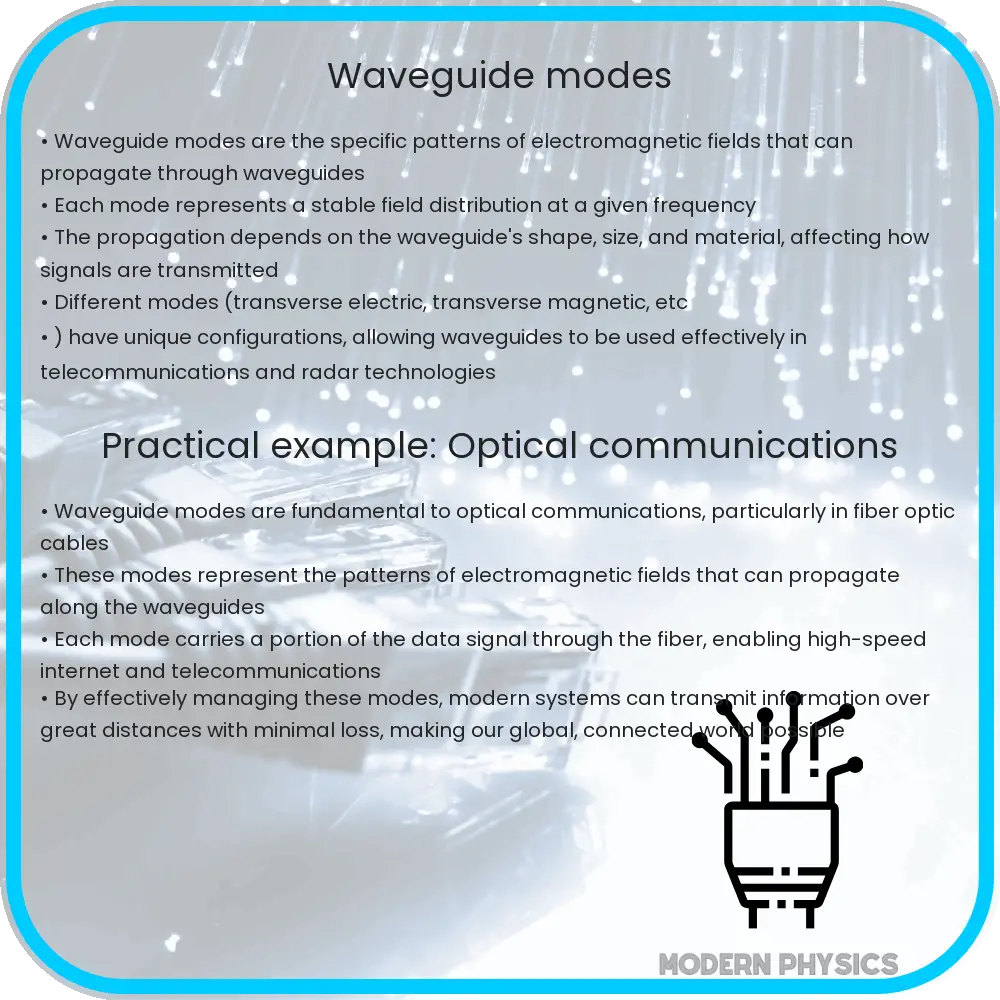Waveguide modes are patterns of electromagnetic fields in waveguides, essential for technologies like fiber optics, microwave engineering, and medical imaging.

Waveguide Modes: Basics, Analysis & Applications
Waveguide modes are fundamental concepts in the field of electromagnetics and photonics. Waveguides are structures that guide waves, such as electromagnetic waves, from one point to another. They are essential in many modern technologies, including fiber optics, microwave engineering, and more. In this article, we will explore the basics of waveguide modes, how they can be analyzed, and their various applications.
Basics of Waveguide Modes
When an electromagnetic wave travels through a waveguide, it doesn’t just propagate freely as it would in open space. Instead, the wave interacts with the boundaries of the waveguide, which can be made of conductive or dielectric materials. These interactions cause the wave to take on specific patterns or modes, which are solutions to Maxwell’s equations confined by the waveguide’s geometry.
- Transverse Electric (TE) Modes: In TE modes, the electric field (E-field) is entirely transverse to the direction of propagation, meaning it has no component in the direction of wave travel.
- Transverse Magnetic (TM) Modes: In TM modes, the magnetic field (H-field) is entirely transverse to the direction of propagation.
- Transverse Electromagnetic (TEM) Modes: In TEM modes, both the electric and magnetic fields are transverse to the direction of propagation. These modes are only supported by waveguides with two or more conductors.
- Hybrid Modes: These have both electric and magnetic field components in the direction of propagation and are found in certain types of complex waveguides.
Analysis of Waveguide Modes
To analyze waveguide modes, we solve Maxwell’s equations with the appropriate boundary conditions imposed by the waveguide’s geometry. This analysis involves the following key steps:
1. Wave Equation Derivation
The wave equation in a waveguide is derived from Maxwell’s equations. For a simple rectangular waveguide, the wave equation can be written as:
(\nabla^2 + \frac{\omega^2}{c^2})E = 0
where \( \nabla^2 \) is the Laplacian operator, \( \omega \) is the angular frequency, and \( c \) is the speed of light in the medium.
2. Boundary Conditions
Boundary conditions depend on the waveguide’s shape and material. For a rectangular waveguide with perfectly conducting walls, the boundary conditions require that the tangential components of the electric field must be zero at the conducting surfaces.
3. Mode Solutions
By applying these boundary conditions, we obtain solutions for the field distributions. For a rectangular waveguide, the solutions are typically sinusoidal functions, leading to discrete modes characterized by integers \( m \) and \( n \). The cut-off frequency, \( f_c \), for each mode determines the minimum frequency at which that mode can propagate and is given by:
f_c = \frac{c}{2} \sqrt{\left(\frac{m}{a}\right)^2 + \left(\frac{n}{b}\right)^2}
where \( a \) and \( b \) are the dimensions of the waveguide’s cross-section, and \( m \) and \( n \) are mode numbers.
Applications of Waveguide Modes
Waveguide modes are crucial in various applications:
- Fiber Optics Communications: Optical fibers use waveguide modes to transmit data over long distances with minimal loss.
- Microwave Engineering: Waveguides are widely used in microwave circuits and antennas, optimizing signal transmission and reception.
- Medical Imaging: Waveguides are used in technologies like MRI, where precise control of electromagnetic waves is essential.
- Military and Radar Systems: Accurate waveguide modes help in the development of high-frequency radar and communication systems.
Types of Waveguides
Waveguides come in various shapes and materials, each suited for specific types of waves and applications:
- Rectangular waveguides: The most common type, used extensively in microwave and millimeter-wave applications.
- Circular waveguides: Often used where rotational symmetry is beneficial, such as in certain antenna feeds.
- Optical fibers: Cylindrical dielectric waveguides used for transmitting light over long distances in optical communication systems.
- Planar waveguides: Consist of a thin film of dielectric material sandwiched between two other materials, used in integrated optics.
Experimentation & Measurement of Waveguide Modes
Practical measurement and experimentation are essential to understanding waveguide modes. Engineers and physicists use various techniques to measure and visualize these modes:
1. Mode Diagnostic Tools
Specialized tools, like network analyzers, measure parameters such as reflection and transmission coefficients to diagnose different modes within the waveguide.
2. Visualization Techniques
Advanced imaging techniques, such as near-field scanning optical microscopy (NSOM), allow for precise visualization of electromagnetic field distributions inside the waveguide.
3. Mode Excitation
To study specific modes, experimental setups often include mode filters and mode launchers that excite and isolate specific modes within the waveguide.
Conclusion
Waveguide modes are foundational to understanding how electromagnetic waves propagate in confined structures, with significant implications in various technological fields. From the basics of TE, TM, TEM, and hybrid modes to detailed analysis involving wave equations and boundary conditions, the study of waveguide modes is both intricate and essential. Practical applications like fiber optics, microwave engineering, and medical imaging leverage these principles to innovate and improve technologies that are integral to modern daily life. By exploring and understanding waveguide modes, we unlock the potential for advancements across many scientific and engineering domains, making our world more connected and efficient.
